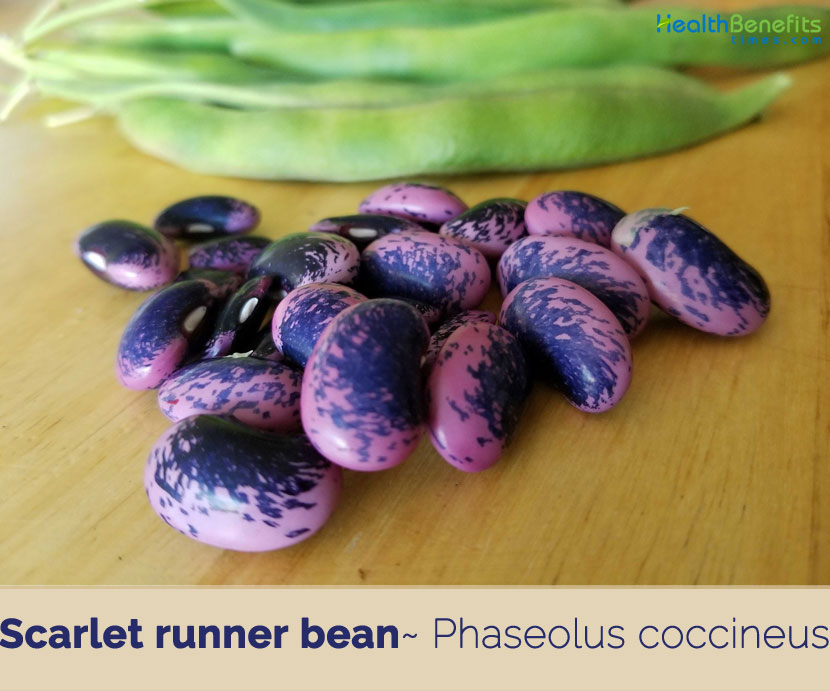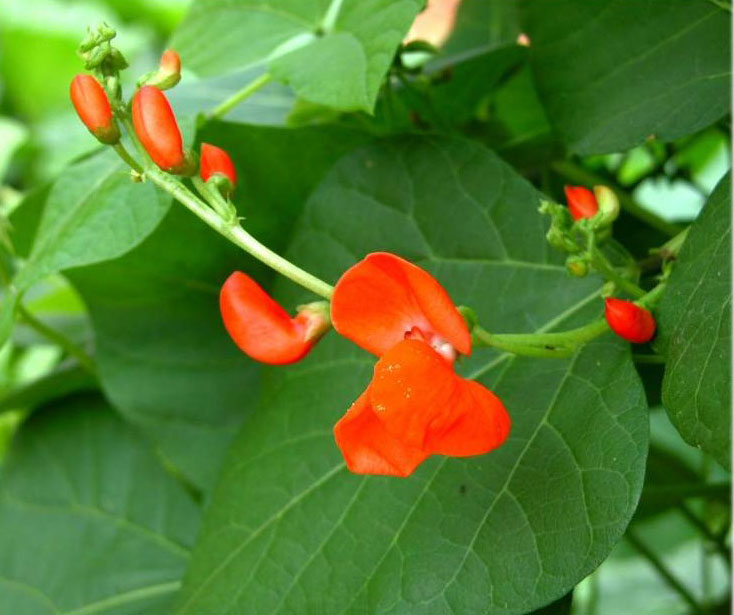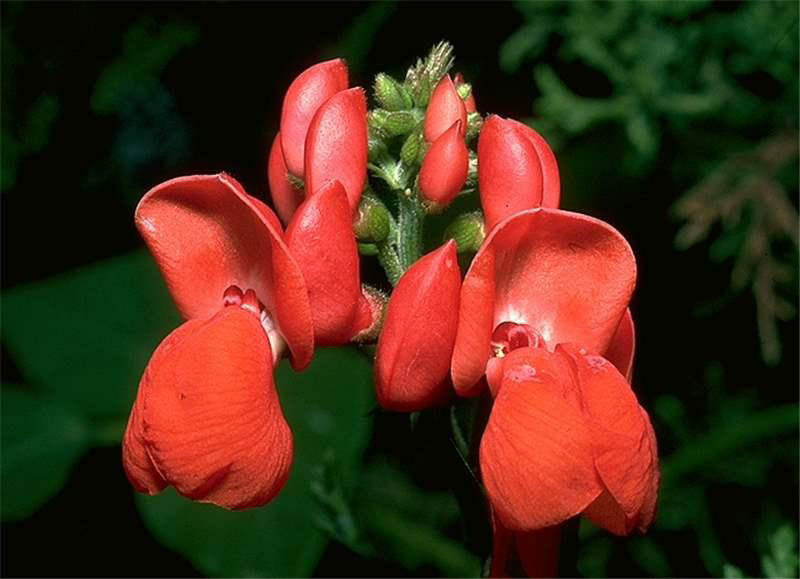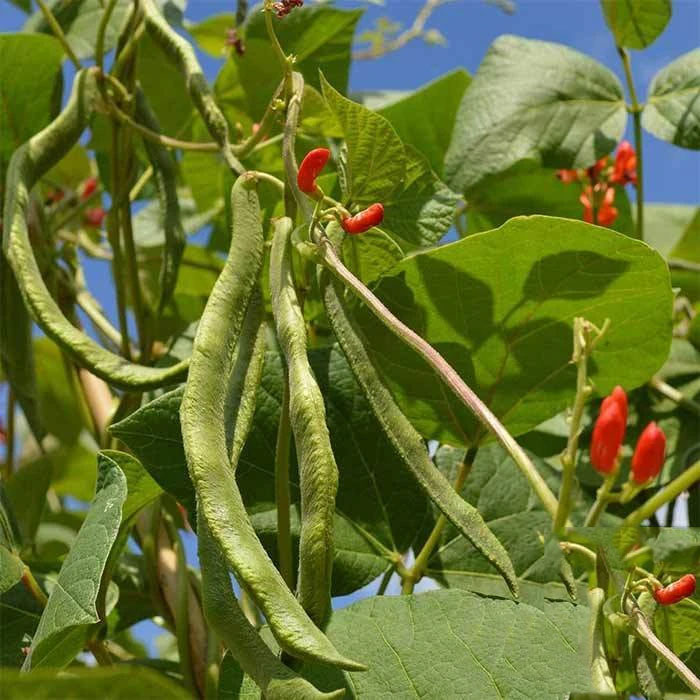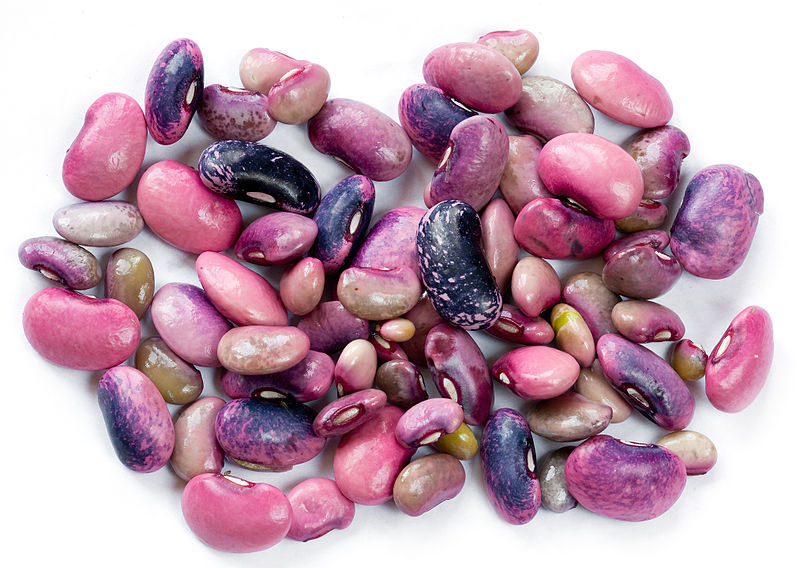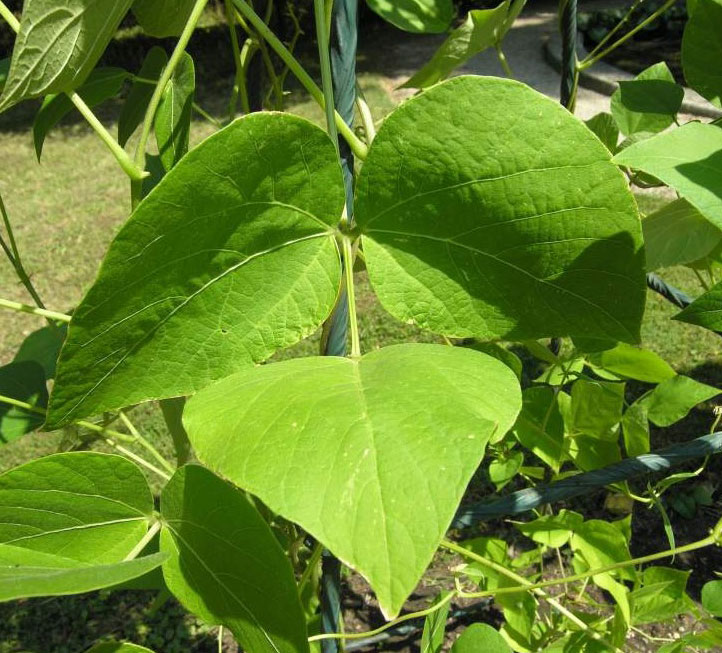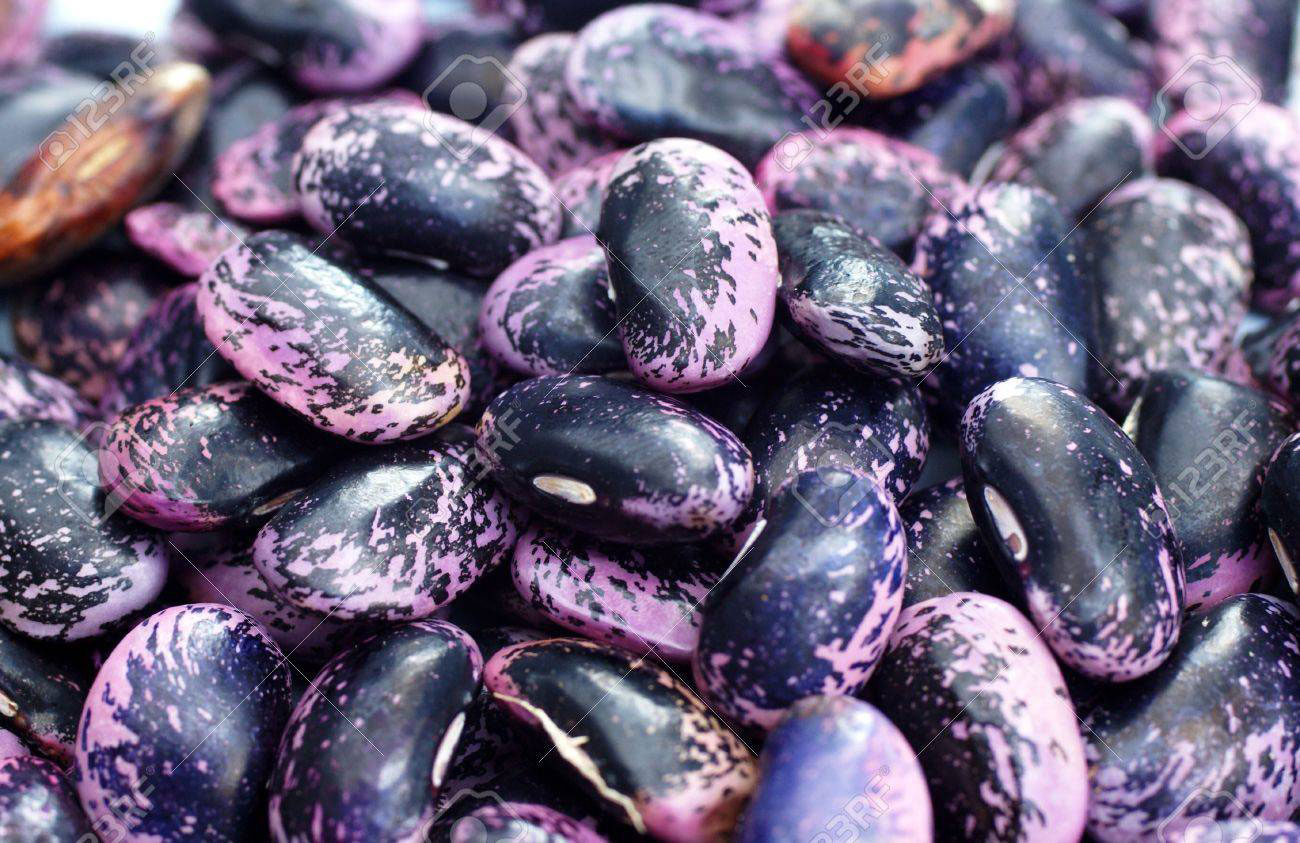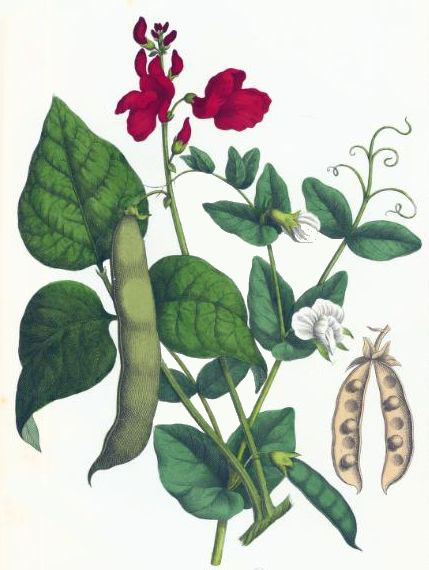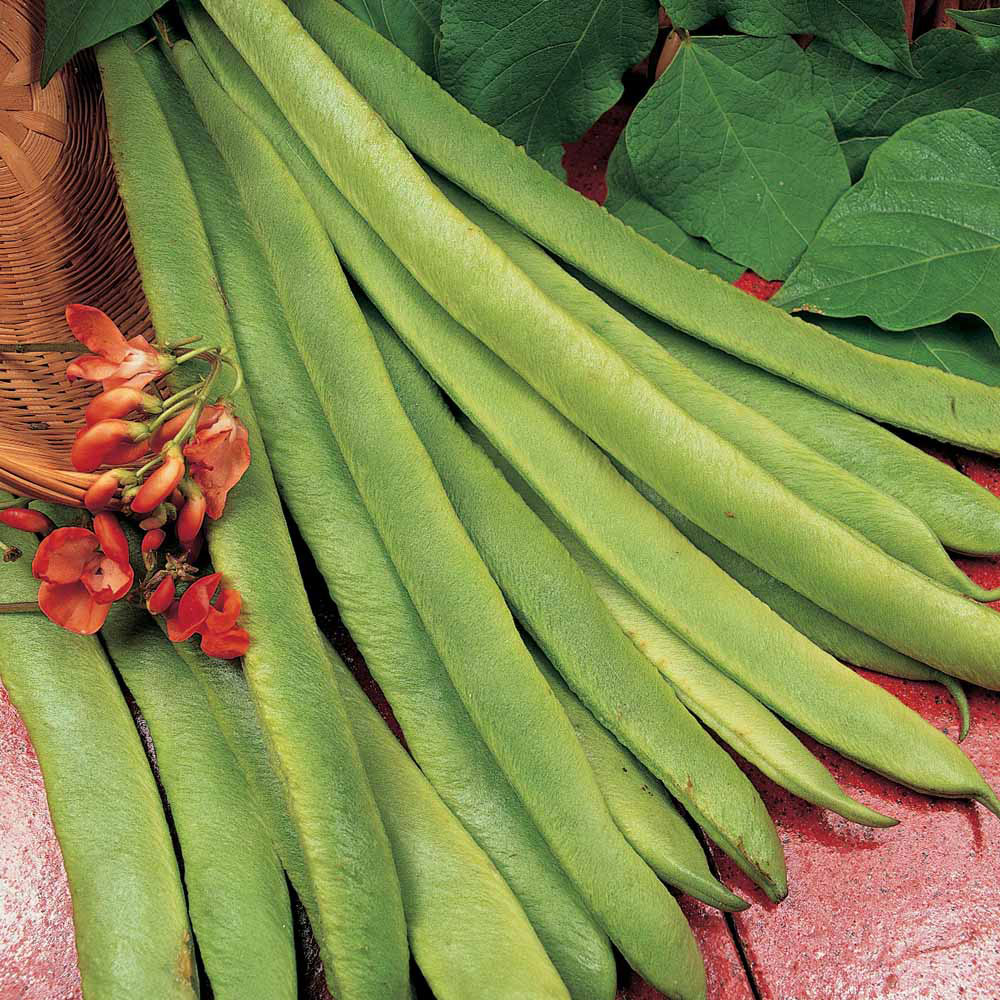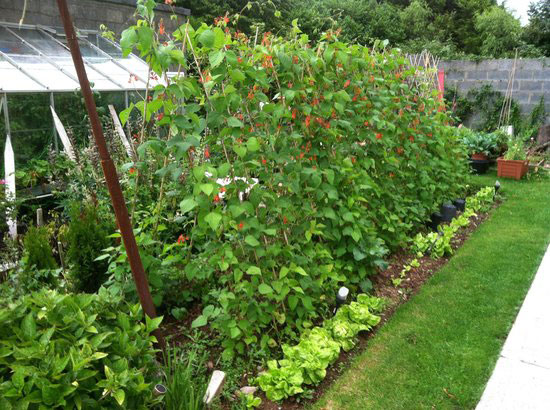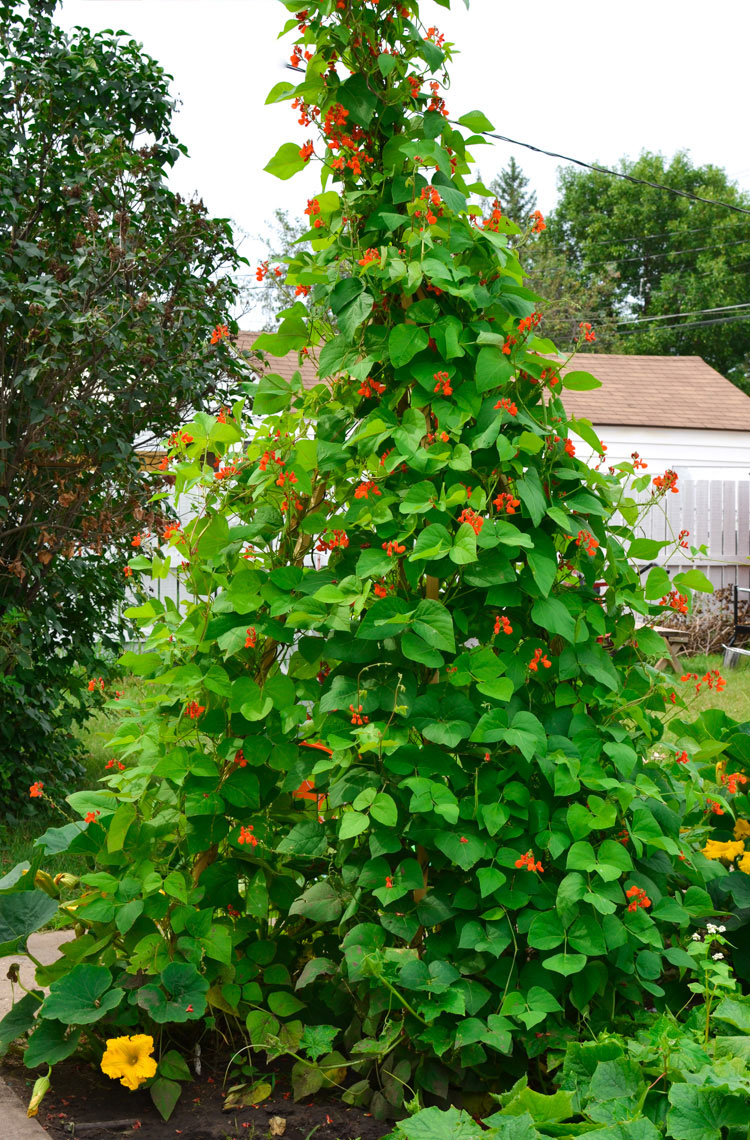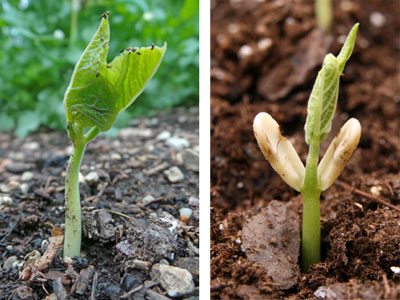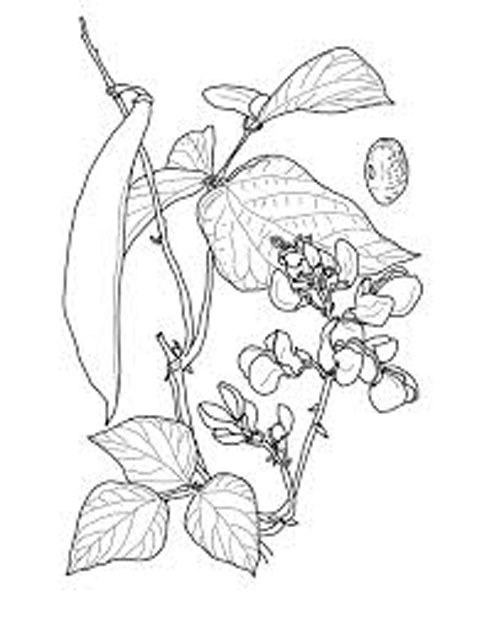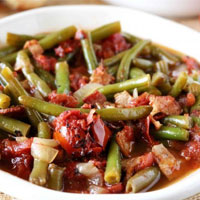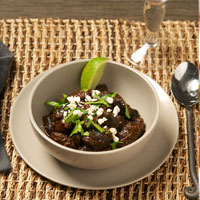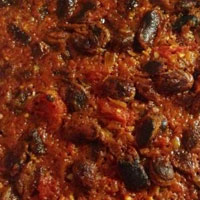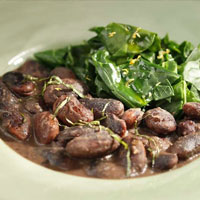Scarlet Runner Beans
| Scarlet runner bean Quick Facts | |
|---|---|
| Name: | Scarlet runner bean |
| Scientific Name: | Phaseolus coccineus |
| Origin | Mexico to Panama and Central America |
| Colors | Green |
| Shapes | Linear-lanceolate, straight or slightly curved pod 9–30 cm long and 1.5–2.5 cm wide |
| Taste | Savory, very nutty, almost meaty flavor |
| Health benefits | Beneficial for malaria, swollen eyes, eczema, heart health, lower the levels of bad or LDL cholesterol, treat infections of the urinary tract, weight loss |
| Name | Scarlet runner bean |
|---|---|
| Scientific Name | Phaseolus coccineus |
| Native | Occurs wild from Mexico to Panama and Central America |
| Common Names | Runner Bean, Scarlet Runner Bean, Scarlet Conqueror, Fire Bean, Mammoth, Red Giant, Dutch runner bean, Case knife bean, seven year bean, Scarlet runner, Red flowered runner bean, Red flowered vegetable bean, Perennial bean, Dutch Case-Knife Bean, multiflora bean, butter bean |
| Name in Other Languages | Afrikaans: Nierboontijie Armenian: Lobi Shikakarmir Azerbaijani: Tyndgyrmyzy Lobya Basque: Babarrun loregorri Brazil: Feijão-trepador Bulgarian: Gradinski fasul (градински фасул) Catalan: Mongeta escarlata, Mongeta patusca, Mongeta vermella, Mongetera, Mongetera vermella Chinese: Hong hua cai dou, Hùhng fà choi dáu, Long zhao dou, he bao dou (荷包豆) Chontal: Limé-gui-ba-né Croatian: Crveni grah Czech: Fazol šarlatový Danish: Pralbønne, Pralbønnen Dutch: Pronkboon English: Scarlet runner, Scarlet runner bean, Runner bean, Red flowered runner bean, Red flowered vegetable bean, Seven year bean, Perennial bean, Dutch Case-Knife Bean, multiflora bean, butter bean Esperanto: Fajrofazeolo Estonian: Oisuba Finnish: Ruusupapu French: Haricot d’Espagne, Haricot a Fleurs Rouges, Haricot écarlate, Haricot-fleur German: Feuerbohne, Käferbohne, Prunkbohne, Arabische Bohne, Blumenbohne, Schminkbohne, Stangenbohne, Türkische Bohne Greek: Φασόλι Ισπανίας (Φασόλι Ισπανίας), Fasóli to ispanikó (Φασόλι το ισπανικό) Hungarian: Török bab, Tűzbab Irish: Pónaire reatha Italian: Fagiolo di Spagna, Fagiolo rampicante di Spagna, Fagiolo scarlatto, Fagiuolo americano, Fagiolo americano, fagiolone Japanese: Beni bana ingen (ベニバナインゲン), Hana mame, hana-sasage Kazakh: Türik burşağı (Түрік бұршағы) Korean: honghwachaedu (홍화채두), bulgeungangnamkong (붉은강낭콩), bulk eun gang nang kong Latvian: Sarkanas Pupinas Lithuanian: Raudonziedes Pupeles Nahuatl: Cimatl Nahya: Xoyamet Netherlands: Pronkboon Norwegian: Prydbønne Otomí: Bénju Persian: لوبیای قرمز Polish: Fasola wielokwiatowa Portuguese: Feijão-da-Espanha, Feijão-de-sete-anos, Feijão-escarlate, Feijão-trepador, Phaseolus lunatus Rarámuri: Recómari Romanian: Fasole Mare, Fasole Turchaske Russian: Fasol’ iarkokrasnaia (Фасоль яркокрасная), Fasol’ mnogotsvetkovaia (Фасоль многоцветковая), Fasol’ ogvenno-krasnaia (Фасоль огвенно-красная), Fasol’ turetskaia (Фасоль турецкая), Turetskie boby (Турецкие бобы), Fasol Ognennokrasnaya, Turkestanskie Boby Serbian: Višnjak (вишњак) Slovenian: Turški fižol Slovakian: Fazuľa šarlátová, Fazuľa Spanish: Ayocote, Botil, Cubá, Frijol angolano, Frijol calentano, Frijol chamborote, Ixtapacal, Judía encarnada, Judia escarlata, Judía pinta, Chilipuca, Chamborote, Chomborote, Pallar, Piloy, Popayán, Poroto de Espagna, Poroto pallar, Tukamulil, Cuba, Judía pinta, Pilay, judión, judía de España, carota florida Swedish: Rosenböna, blomsterböna, spansk klängböna Totonaco: Clankastapu Turkish: Bombay fasulyesi, Ateş fasulyesi Ukrainian: Koroliv Tzvit, Kvasolya Vognyanochervona (квасоля вогняно-червона) Welsh: Ffeuen ddringo |
| Plant Growth Habit | Climbing (vining), tuberous perennial or a bushy (dwarf), annual herb |
| Growing Climates | In or around mostly mixed forests, often on steep slopes or along stream beds, open wooded grassy areas, or on edges of cloud forest |
| Soil | Warm sheltered sunny position in a consistently moist, fertile, organically rich well-drained soil with plenty of moisture in the growing season. Dislikes heavy, wet or acid soils |
| Plant Size | Grow to 3 m (9 ft) or more in length |
| In Leaf | May to October |
| Leaf | Trifoliate and all the leaflets are broadly oval, measuring anything between 10 cm and 12.7 cm in length |
| Flowering season | July to September |
| Flower | Flowers are about an inch long and clustered on many-flowered racemes up to 10 inches long. There can be as many as 20 flowers on a single flowering stalk |
| Fruit Shape & Size | Linear-lanceolate, straight or slightly curved pod 9–30 cm long and 1.5–2.5 cm wide, laterally compressed, beaked, glabrescent, rough with small oblique ridges, 3-10 seeded |
| Fruit Color | Green |
| Seed | Ellipsoid-oblong, 13–25 mm long and 6–13 mm wide, black, white, cream or brown, often pink to purple mottled |
| Propagation | By seed |
| Taste | Savory, very nutty, almost meaty flavor |
| Season | August to October |
| Other Facts |
|
| Precautions |
|
Unlike common beans, the plant is a perennial vine with tuberous roots, though not typically treated as such within agricultural methods and cycles. There are nearly twenty different cultivars (man-made types) of Scarlet runner bean, and all are known for the colorful seeds the pods produce. True to their name they are first and foremost known for their bright scarlet blooms, so much that in most seed catalogs they are listed under “ornamental”, “flowers”, or “hummingbird plants” rather than “beans.” Today the Scarlet runner is mainly grown as an ornamental in the United States though it is available when in season from local farmers markets. In Europe runner types such as the Scarlet have long been a popular edible bean both whole in their immature form and when mature and shelled for their edible seeds.
Plant Description
Scarlet runner bean is a climbing (vining), tuberous perennial or a bushy, annual herb that grows up to 3 m (9 ft.) or more in length. The plant is found growing in or around mostly mixed forests, often on steep slopes or along stream beds, open wooded grassy areas, or on edges of cloud forest. The plant prefers warm sheltered sunny position with a consistently moist, fertile, organically rich well-drained soil with plenty of moisture in the growing season and normally dislikes heavy, wet or acid soils. Leaves of Scarlet runner bean are trifoliate and all the leaflets are broadly oval, measuring anything between 10 cm and 12.7 cm in length. Most varieties have red flowers and multicolored seeds (though some have white flowers and white seeds), and they are often grown as ornamental plants.
Flower
Flowers in most cultivars are bright scarlet red, and shaped like typical bean family flowers with the two lowermost petals united into a keel, the uppermost petal modified into a hood like standard, and the lateral petals modified into spreading wings. The flowers are about an inch long and clustered on many-flowered racemes up to 10 inches long. There can be as many as 20 flowers on a single flowering stalk. Flowering usually takes place from July to September.
Fruits
Fertile flowers are followed by linear-lanceolate, straight or slightly curved pods that are 9–30 cm long and 1.5–2.5 cm wide, laterally compressed, beaked, glabrescent, and rough with small oblique ridges, 3-10 seeded. Seeds are ellipsoid-oblong, 13–25 mm long and 6–13 mm wide, black, white, cream or brown, often pink to purple mottled. The green pods are edible whole but in some varieties (the scarlet runner) tend to become fibrous early, and only the seeds within are eaten. The seeds can be used fresh or as dried beans. The starchy roots are still eaten by Central American Indians.
Beans are delicious when young, but if left on the vine will eventually develop into large tough pods to 1.5 feet long. Runner bean is basically the same thing as a pole bean (American term) in that both do basically the same thing, namely, climb and produce edible beans. Runner beans produce flowers about 4-5 weeks after planting of the seed, with first harvest in 60-75 days. Picking the beans encourages production of additional flowers.
In addition to being handsome ornamental climbers, runner beans also attract hummingbirds, butterflies and bees. Runner beans twine clockwise whereas most other types of beans twine counterclockwise.
History
Scarlet runner bean occurs wild from Mexico to Panama. It was probably domesticated in Mexico. Archaeological evidence shows that scarlet runner bean was a domesticated crop in Mexico around 900 AD. Nowadays scarlet runner bean is cultivated in temperate countries and occasionally in highland areas of Central and South America, Africa (e.g. Ethiopia, Kenya, Uganda, and South Africa) and Asia. It is probably cultivated in Madagascar and is recorded as being grown in the eastern part of tropical southern Africa, although no specific countries are mentioned.
Traditional uses and benefits of Scarlet runner bean
- Root decoction is taken against malaria or applied to swollen eyes.
- They are an excellent natural resource of vitamin K, which is essential for the health of our bones.
- Spraying a decoction prepared with runner beans on skin areas affected by eczema helps to alleviate itching.
- At the same time, it is useful in keeping the skin at the affected areas dry.
- Runner beans also possess potent diuretic properties. Therefore, consuming runner bean seeds and pods helps to promote urination, thus eliminating toxins from our body.
- Antioxidant properties of these beans make them a valuable food for the health of our heart.
- These beans are also good for the health of our cardiovascular system.
- Runner beans also encircle significant levels of dietary fibers that are useful in lowering the levels of bad or LDL cholesterol in the blood stream.
- Consumption of runner beans during pre-conception as well as during pregnancy is helpful in putting off defects in the neural tube of an offspring.
- Drinking a tea prepared from runner bean pods is useful in treating infections of the urinary tract.
- It also helps to reduce weight.
Culinary Uses
- Immature seedpods can be consumed raw or cooked.
- Seedpods have a pleasant mild flavor and are widely used as a vegetable in many areas of the world.
- They can be added to salads, cooked as a vegetable or added to soups, stews etc.
- The immature seed is used like shelled beans as a vegetable.
- The protein-rich mature seeds can be dried and stored for future use.
- They are soaked for 12 hours prior to use and are eaten boiled or added to soups etc.
- Seed can also be ground into a powder and added to cereal flours for making protein-enriched bread etc.
- Young leaves can be cooked and used as a potherb.
- Root can be consumed after being cooked and is rich in starch.
- Starchy roots are still eaten by Central American Natives.
- In Central America the young shoots, leaves and inflorescences are sometimes used (boiled or boiled and fried) as a vegetable while the tuberous roots are consumed boiled or chewed as candy.
- Edible pods, however, are only edible when they are young.
- In some parts of the world, the flowers are also eaten by adding them to salads.
- Scarlet runner beans work well as a pot bean and will compliment soups, chili, and stews.
Stewed Runner Beans with Tomatoes
Ingredients
- 2 tablespoons olive oil
- ½ pound onions, cut into wedges
- ½ cup diced red peppers, sweet or mildly hot
- 4 garlic cloves, crushed
- 1 quart canned tomatoes, with their juice
- 3 fennel seeds
- 2 pinches ground saffron
- ½ cup chopped parsley
- Ground black pepper
- 12 ounces (about 2 cups) dried Scarlet Runner Beans, boiled until tender with a sprig of sage and a garlic clove
- Salt
Directions
- In a large skillet, sauté the onions.
- Add the peppers and garlic, and sauté until the garlic releases its fragrance.
- Add the tomatoes, fennel, saffron, and parsley, and twist the pepper mill over the pan two or three times.
- Break up the tomatoes with a spoon or spatula.
- When the mixture is hot, add the beans. Boil the mixture about 10 minutes, until it’s suitably thick.
- Add salt to taste, and serve with bread or rice.
Scarlet runner beans with Chili Sauce
Ingredients
- 1 pound dried scarlet runner beans
- 4 ancho chilies, stemmed and seeded
- 1 onion, quartered
- 3 garlic cloves
- 1 cup chicken broth or water
- 1 teaspoon cumin seeds, toasted and ground
- salt and freshly ground black pepper to taste
- crumbled queso fresco or feta for garnish
- chopped fresh cilantro for garnish
- lime wedges for garnish
Directions
- Place the beans in a large bowl and cover with at least one inch of water; let soak overnight.
- Add the beans and their soaking water to a large pot. The beans will have expanded, so make sure they are still covered by at least an inch, maybe a bit more. Turn your heat to medium high and bring to a hard boil.
- Keep the beans at a boil for about five minutes and then reduce them to a gentle simmer, then cover. When the beans are almost ready, the aroma will be heady. If the bean water starts to get low, always add hot water from a tea kettle.
- Meanwhile put the chilies in a small bowl, add hot water to cover, and soak until soft, about 15 minutes. Drain the chilies and put them in a blender with the onion and garlic.
- Purée until smooth, adding some chicken broth or water to thin the mixture if necessary, the texture should be like a pourable pesto. You should have about 1 1/2 cups of chili purée.
- In a small, heavy skillet over medium-low heat, cook the purée, stirring occasionally, until the bitter flavor begins to mellow, about 15 minutes. Add the cumin and salt and pepper to taste and cook for 10 minutes to blend flavors.
- When the beans are beginning to soften, after about one hour, add the chili purée and season the whole mix with salt and pepper. Continue cooking until the beans reach the desired texture, depending on their age, another 15-45 minutes.
- Serve as a vegetarian main dish or as a super healthy side topped with queso fresco, chopped cilantro and a spritz of lime.
Scarlet Runner bean casserole
Ingredients
- 300 g scarlet runner beans (dry or 400 g canned)
- 100 ml olive oil
- 1 onion (white, large)
- 3 garlic cloves (minced)
- 4 tomatoes (fresh or 1 large can tomatoes without juice)
- salt and pepper
Directions
- If using dried beans, soak them overnight and cook according to package instructions (usually for 90min.).
- Cut onion in about 0,5cm pieces, mince garlic, peel and seed tomatoes (put in boiling water for about 30sec.) and chop into bite size pieces.
- Heat olive oil and add onion and garlic. Let fry until translucent.
- Add beans and tomatoes. Stir.
- Salt and pepper to taste.
- Transfer to baking dish and let bake for about 20-25 minute at 175°C (until the beans go lightly crispy).
- Enjoy with white bread, such as baguette, ciabatta or pita. The oil onion mixture tastes heavenly when dipped into.
Scarlet runner beans and Bacon
Ingredients
- 1 pound Scarlet Runner beans
- 4 ounces smoked bacon
- Olive oil, as needed
- 1/2 large white onion, diced small (about 1 cup)
- 3 large garlic cloves, peeled and smashed
- 1 tablespoon Amontillado sherry
- 1 3/4 cups (14-ounce can) chicken or beef broth
- 2 medium bay leaves
- 1/2 teaspoon dried thyme
- 2 large pinches red pepper flakes
- Black pepper, to taste
- Kosher salt, to taste
- Large pinch espresso powder, to taste (optional)
- Basil, optional garnish
Directions
- Pick through beans, rinse and place in a pot or bowl with about 1 1/2 inches of water to cover; soak 4 to 6 hours at room temperature.
- When ready to cook, cut the bacon crosswise into narrow pieces; place in a large pot or Dutch oven over medium heat. Cook, stirring frequently, until the bacon is browned and the fat is rendered out.
- Add a little oil to the pot if there is not enough bacon fat, and then add the onions.
- Cook until they begin to turn translucent, scraping the bottom of pot to help incorporate any browned bits. Add the garlic and briefly cook until aromatic.
- Pour in the sherry, and bring to a boil; let cool down a bit, then add broth, bay leaves, thyme, red pepper flakes and beans.
- Add water to cover beans by at least 1 inch, cover and reduce heat to a low simmer. Cook about 1 hour, stirring once or twice and checking the water level; if needed, add more to keep beans fully submerged.
- Add black pepper and salt lightly to taste. Add a large pinch of espress powder.
- Continue to cook until the beans are tender but not falling apart, another 1 to 1 1/2 hours, depending on the size and freshness of the beans.
- Place 1/2 to 1 cup of beans in a blender with enough broth to puree. Puree, then return to the dish to thicken to desired consistency.
- Adjust seasoning. Serve warm with thinly sliced basil, if desired.
References:
https://www.itis.gov/servlet/SingleRpt/SingleRpt?search_topic=TSN&search_value=26845#null
https://npgsweb.ars-grin.gov/gringlobal/taxonomydetail.aspx?id=27563
https://pfaf.org/user/plant.aspx?LatinName=Phaseolus+coccineus
http://www.missouribotanicalgarden.org/PlantFinder/PlantFinderDetails.aspx?taxonid=280328
http://www.floracatalana.net/phaseolus-coccineus-l-
https://plants.usda.gov/core/profile?symbol=PHCO6
https://en.wikipedia.org/wiki/Phaseolus_coccineus
https://pgrc.agr.gc.ca/cgi-bin/npgs/html/taxon.pl?27563
https://uses.plantnet-project.org/en/Phaseolus_coccineus_(PROTA)
https://www.cabi.org/isc/datasheet/40618
http://www.theplantlist.org/tpl1.1/record/ild-2930
https://uses.plantnet-project.org/en/Phaseolus_coccineus_(PROSEA)
https://prota4u.org/database/protav8.asp?g=pe&p=Phaseolus+coccineus+L.
https://gd.eppo.int/taxon/PHSCO
https://www.flowersofindia.net/catalog/slides/Scarlet%20Runner%20Bean.html


